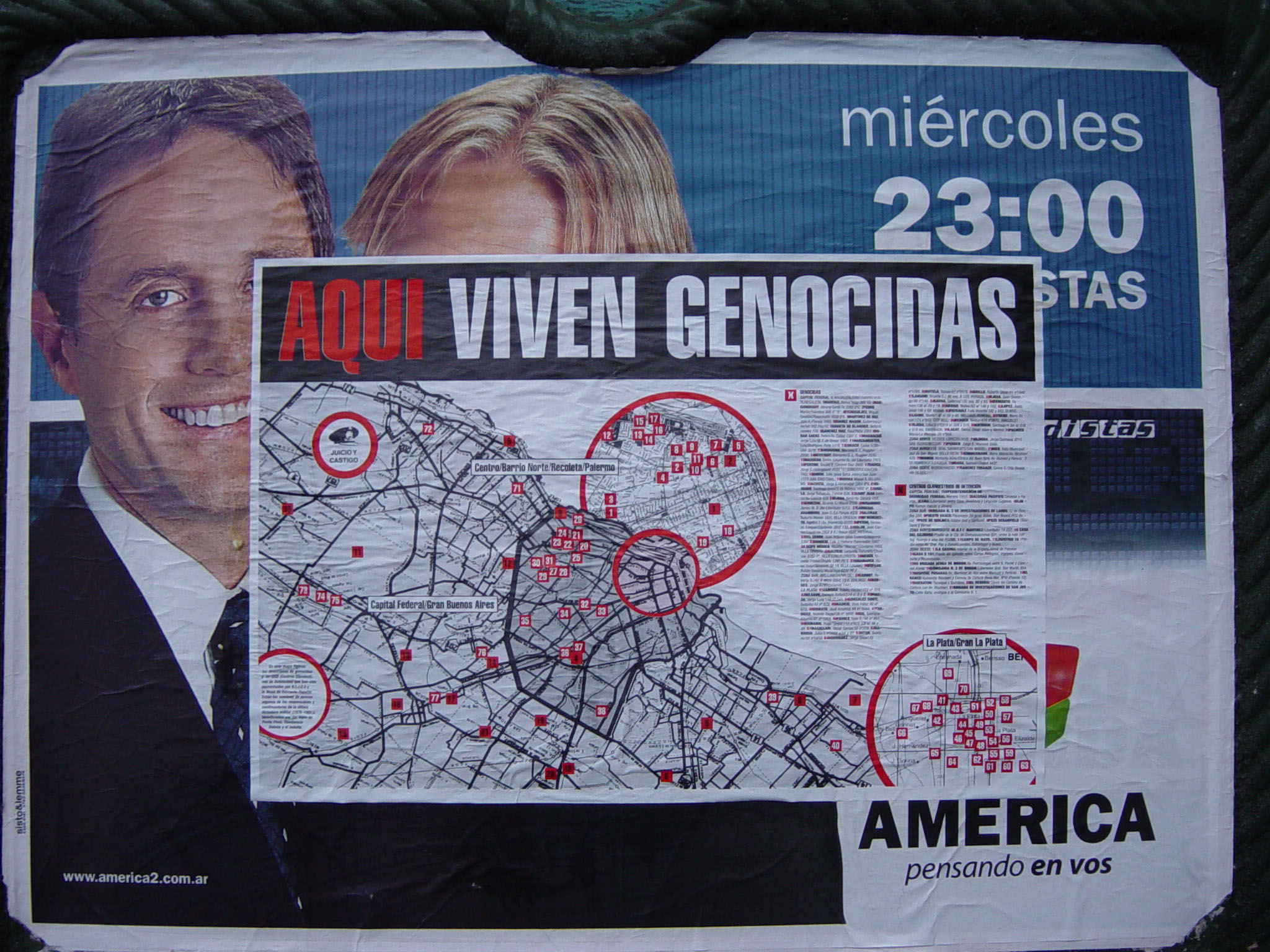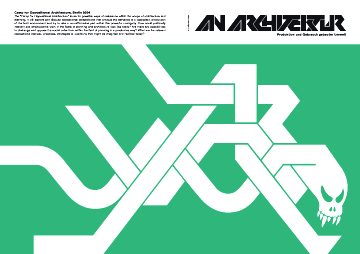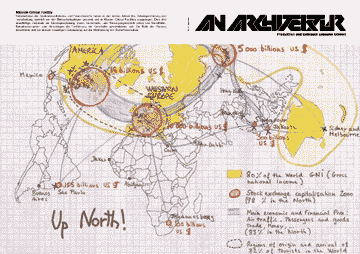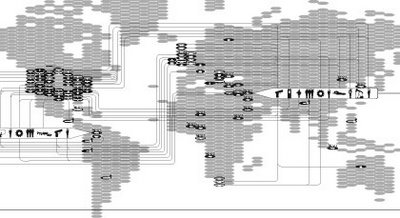
Situating Rights / e-misférica, vol. 3, issue 1, June 2006 / Hemispheric Institute for Performance and Poltics
The Grupo de Arte Callejero (GAC) has engaged in acts of urban intervention since the late 80s, dealing with issues of human rights. Together with H.I.J.O.S. (Hijos por la Identidad contra el Olvido y el Silencio, an organization formed by the children of the disappeared), GAC actively participates in the “escraches” (acts of public shaming) that expose the specific places where dictatorship has carried out its injustice and impunity—e.g., current homes of ex-torturers, buildings that were used as detention and torture centers, etc. During recent years, GAC has expanded its activism to single out other modes of injustice under democracy, such as the criminalization of social protests, the impunity of police officers in the state of security, the news media’s monopoly and the housing market. Their actions, which are local and anonymous, use different levels (performatic, graphic and textual) to interfere and subvert the discourses that authorize, legitimize and legalize injustice.

Escraches
The Grupo de Arte Callejero (Group of Street Art) came into existence with its work with H.I.J.O.S. (Sons and Daughters for Identity and Justice Against Oblivion and Silence) at the end of the 1990s, actively participating on the escraches1 against former members of the dictatorship who were responsible for kidnapping, torturing, and disappearing dissident citizens. It was a time when the democratic polity was dominated by a pact of silence, sealed with presidential pardons to perpetrators and a neo-liberal economic policy. GAC's interventions on traffic signs re-signified the topography of the city by marking the direction and distance to the homes of former torturers.
Escrachar is slang for 'to put into evidence, disclose to the public, or reveal what is hidden.'

Plan Nacional de Desalojo
Without abandoning the escraches, GAC's actions have expanded and diversified. Two different stages of human rights struggle coexist today. On the one hand, the commitment for justice against perpetrators of genocide persists; on the other, a stage in which multiple rights emerge under the legitimizing umbrella of human rights: the right to dignified housing against real estate speculation, the right of original peoples to the possession of their land, the right to protection against police brutality and the criminalization of everyday life, the right to public communication against mass media monopoly, the right to work and to take occupy businesses that have been deserted by their owners. GAC's interventions are not limited to highlighting these rights, but they are engaged in creating social practices that put these rights to work.
The municipal government of Buenos Aires implemented an eviction program in several areas of the city, most notably in the neighborhood of San Telmo, the historical center. Dozens of families were violently evicted from various buildings in this area. Real estate and financial businesses with ties to the tourist industry were the major forces behind the evictions.
A week after these initial episodes, we put up a stand in one of the busiest intersections, from which the “official” employees of the “Ministry of Control” interviewed residents and tourists. A questionnaire was used, and participants were asked how they would like to be evicted, how they would like to surrender their right to housing, and how they would like to be cast out of society. The same action has been performed on many occasions in this neighborhood, as well as in other places around the city (e.g., at a shopping center).

Anti-monumento a Roca
The action that we present here denounces the celebration of the so-called 'Campaign to the Desert' (1879). That campaign, under the direction of the general Julio Argentino Roca, was a war of extermination launched against the native inhabitants of Patagonia in an epoch of national consolidation. GAC's action consists of a public ceremony of desecration of the monument to the patriotic 'hero,' which is situated in the historical core of downtown Buenos Aires.
The intervention underscores historical continuities between past and present: from the process of territorial colonization of the nation-state opened by the newly created army (representing its first internal job by which it 'modernizes' its potential with the acquisition of Remington rifles to be used against the indians), to the subsequent oligarchic state rule (represented by the Rural Society), to the alliance with transnational capital of the last dictatorship and its continuity in the neo-liberal democracy of the 1990s (represented by the Spanish corporation Repsol which has exploited Patagonian oil wells since that decade of privatization of national companies, and by Benetton).
Exceptional Bodies: Performance and Law / By Jill Lane
"... For Gustavo Buntinx, reflecting on the Colectivo Sociedad Civil in Lima, Perú, and for the artists of Grupo de Arte Callejero (GAC) in Buenos Aires, Argentina, the struggle for a public sphere is staked in questions of the legitimacy of the nation itself. Buntinx focuses on what he calls "zonas ultraperiféricas," where histories of colonial and neocolonial violence and exploitation have produced "el nacionalismo sin nación de repúblicas sin ciudadanos." Both arts collectives aim at creating and rehearsing viable forms of civil society and citizenship against the radical negligence of the state—whether the aggressive dismantling of the democratic state in Fujimori's de facto dictatorship or the impassive erasures in public memory of genocide and colonial violence in contemporary Argentina. For both groups, art is the site of a new form of civic engagement: both use performance to make claims against the sovereign state, to illustrate its corruption, and to stake new forms of political agency...."

Periferia - grupo de arte callejero
Manifiesto I (de la urgencia)
Manifiesto II (de la construcción)
Manifiesto III (de la comunicación)

La Biennale di Venezia / 50th International Art Exhibition / 2003
The Structure of Survival / Curated by Carlos Basualdo
Cartografía del control / Cartography of control / Video projection and collage
Marked on a piece of a map of Buenos Aires (an area along the heavily polluted river Riachuelo): centers of economic power, acts of military repression, places of warlike conflicts, militarized zones, US military bases. A video projection plays on the side of the wall.
The Future of the Reciprocal Readymade / The use-value of art / apexart
By and large, when artworlders talk about what might be broadly described as art's 'use value,' they're bluffing. Anyone who believes that art, in any conventional sense of the term, by 'questioning,' 'investigating,' or otherwise 'depicting' some socio-political issue, actually empowers anyone to do anything about it, is actively engaged in self-delusion. Yet art continues to make such promises — using its institutions to lend them not only a largely unchallenged semblance of truth, but all the trustworthiness of convention — only to immediately break them. Why? Is it because art is unable to do away with its romantic underpinnings, except by abandoning itself to all-out cynicism?
More likely, it is because art remains caught in an essentially representational paradigm, protected from the real, which allows the symbolic transgressions of the artworld to be confused with the real-life political activism that occurs in the judicial, penal and civil spheres of society. In and of themselves, of course, such 'picture politics' are not void of use-value: for the artworld élite that likes that sort of thing, the concentrated, composed and self-reflective works one finds in museums have a contemplative value that is far from negligible, in terms of refining perceptive awareness or stimulating sense-based cognition. But all that falls far short of what art implicitly leads us to expect — which is what makes our relationship to art one of constantly renewed, constantly dashed hopes.
Grupo Etcetera @ [iDC]
Precarity, Social Movements and Political Communication: Forms of auto-organization and communication strategies in the era of globalization / By Martín Bergel and Julia Risler / Translated Brian Whitener
Misc.

H.I.J.O.S.
Somos H.I.J.O.S, Hijas e Hijos por la Identidad y la Justicia contra el Olvido y el Silencio. Somos hijas e hijos de desaparecidos, presos políticos, fusilados, exiliados, asi como jóvenes que sin haber sufrido en su propia familia la represión directa, comprendemos que somos hijos de una historia de represión como de luchas.
Somos una organización política que, desde los derechos humanos, lucha por un mundo más justo y denuncia las violaciones de ayer y hoy. Como organización iniciamos nuestro trabajo en 1995 pero nuestras raíces tienen más de treinta años. Somos hijos del horror, del genocidio y la represión pero también somos hijos de mujeres y hombres que soñaban con un mundo distinto y luchaban para construirlo.
Argentina 30 Years after the Coup / By Marie Trigona / IRC / March 29, 2006
This March 24, Argentines commemorated the 30 year anniversary of the nation’s 1976 military coup and the brutal nightmare of state terror that followed. Throughout the week, human rights groups remembered the 30,000 people who were disappeared with a series of rallies and cultural events.
Without a doubt, anniversary commemorations were much larger this year than in the past. Massive crowds could barely squeeze into the Plaza de Mayo and tens of thousands spilled over into the connecting avenues during the demonstration on March 24. Along with the masses that returned to the streets for the first time in decades, polemic debate among human rights groups accompanied this year's commemorations.
You Are Here: The DNA of Performance / By Diana Taylor
TDR: The Drama Review - Volume 46, Number 1, Spring 2002
Among the mothers and the children of the "disappeared" in Argentina, performance of various kinds is a way of marking, accusing, and remembering. How can performance transmit traumatic memory? How do those of us who have not suffered the violence come to understand it? And how do we participate, in our own ways, in further transmitting it?
El espectáculo de la memoria: trauma, performance y política / By Diana Taylor

















